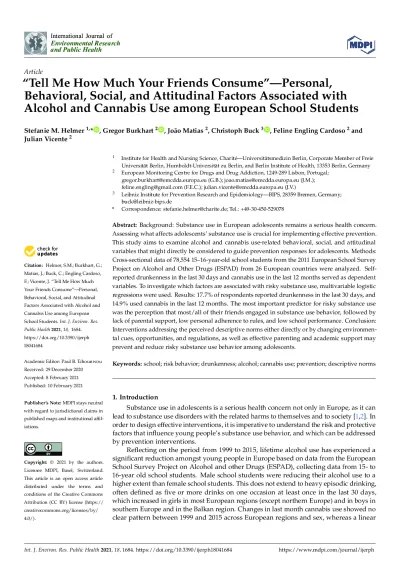Summary
Substance use in European adolescents remains a serious health concern. Assessing what affects adolescents’ substance use is crucial for implementing effective prevention. This study aims to examine alcohol and cannabis use-related behavioral, social, and attitudinal variables that might directly be considered to guide prevention responses for adolescents. Methods: Cross-sectional data of 78,554 15–16-year-old school students from the 2011 European School Survey Project on Alcohol and Other Drugs (ESPAD) from 26 European countries were analyzed. Self-reported drunkenness in the last 30 days and cannabis use in the last 12 months served as dependent variables. To investigate which factors are associated with risky
Download as PDF
Open access PDF
PDF files are made available as a convenience. In cases where the EMCDDA is not the originator of the document, please be aware that any PDFs available on this page may not be authoritative or there may be more recent versions available. While we make every effort to ensure that these files are definitive, before using or citing them, we recommend that you consult the publisher's website or contact the author(s) to check for more recent versions.
Abstract
Background: Substance use in European adolescents remains a serious health concern. Assessing what affects adolescents’ substance use is crucial for implementing effective prevention. This study aims to examine alcohol and cannabis use-related behavioral, social, and attitudinal variables that might directly be considered to guide prevention responses for adolescents.
Methods: Cross-sectional data of 78,554 15–16-year-old school students from the 2011 European School Survey Project on Alcohol and Other Drugs (ESPAD) from 26 European countries were analyzed. Self-reported drunkenness in the last 30 days and cannabis use in the last 12 months served as dependent variables. To investigate which factors are associated with risky substance use, multivariable logistic regressions were used.
Results: 17.7% of respondents reported drunkenness in the last 30 days, and 14.9% used cannabis in the last 12 months. The most important predictor for risky substance use was the perception that most/all of their friends engaged in substance use behavior, followed by lack of parental support, low personal adherence to rules, and low school performance.
Conclusion: Interventions addressing the perceived descriptive norms either directly or by changing environmental cues, opportunities, and regulations, as well as effective parenting and academic support may prevent and reduce risky substance use behavior among adolescents.









